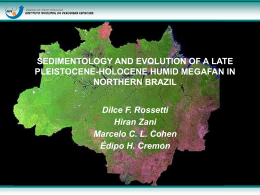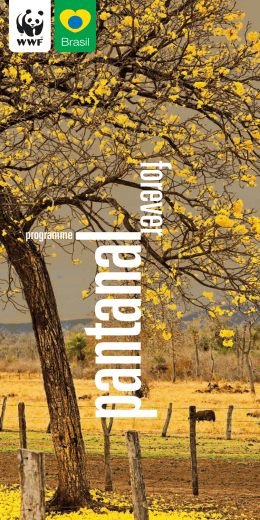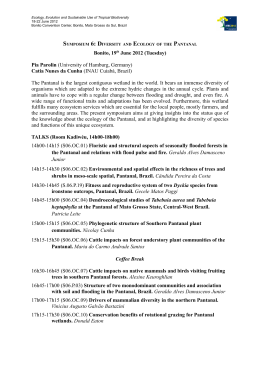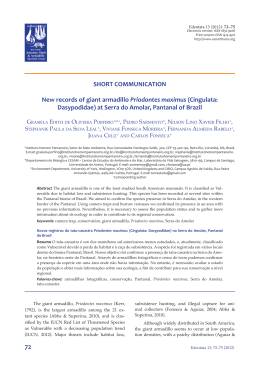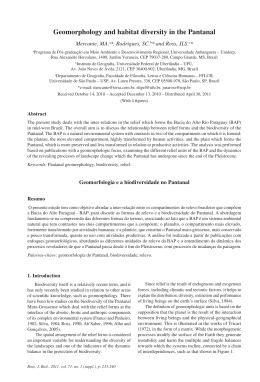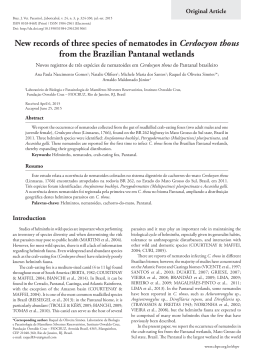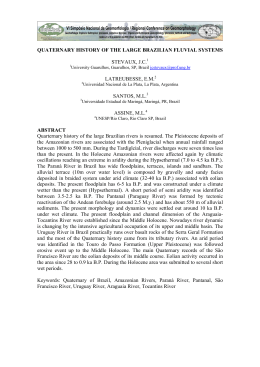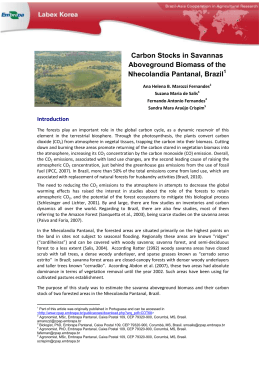SHORT COMMUNICATION HAEMOGREGARINE PARASITES (APICOMPLEXA: HEPATOZOIDAE) IN Caiman crocodilus yacare (CROCODILIA: ALLIGATORIDAE) FROM PANTANAL, CORUMBÁ, MS, BRAZIL LÚCIO A. VIANA1*; ELIÉZER J. MARQUES1 ABSTRACT:- VIANA, L.A.; MARQUES, E.J. Haemogregarine parasites (Apicomplexa: Hepatozoidae) in Caiman crocodilus yacare (Crocodilia:Alligatoridae) from Pantanal, Corumbá, MS, Brazil. [Hemogregarina (Apicomplexa: Hepatozoidae) em Caiman crocodilus yacare (Crocodilia:Alligatoridae) no Pantanal, Corumbá, MS, Brasil.] Revista Brasileira de Parasitologia Veterinária, v. 14, n. 4, p. 173-175, 2005. Departamento de Biologia, Universidade Federal de Mato Grosso do Sul, Cidade Universitária s/n, Campo Grande, MS, 79070-900, Brasil. E-mail: [email protected] Haemogregarines were recorded in caimans Caiman crocodilus yacare from Pantanal. This study was carried out in seasonal ponds at the Miranda-Abobral subregion of Pantanal, State of Mato Grosso do Sul, western Brazil, from 1998 to 1999. Smears from 28 caimans were examined and 20 (71.4%) presented infection by a haemogregarine. Infections were observed in 11 males and 9 females. Morphological and morphometric observations suggest that the parasite forms found in this work are Hepatozoon caimani. KEY WORDS: Caiman crocodilus yacare, Pantanal, haemogregarine. RESUMO Hemogregarinas foram observadas em jacarés-do-Pantanal, Caiman crocodilus yacare. Este estudo foi realizado em lagoas sazonais no Pantanal de Mato Grosso do Sul, na sub-região do Miranda e Abobral, Brasil, entre os anos de 1998 e 1999. Esfregaços de 28 C. c. yacare foram examinados e 20 (71.4%) apresentaram o parasita. As infecções foram observadas em 11 machos e 9 fêmeas. Comparações morfológicas e morfométricas sugerem que o parasita encontrado seja Hepatozoon caimani. PALAVRAS-CHAVE: Caiman crocodilus yacare, Pantanal, haemogregarina. Caiman crocodilus yacare can be found all around Pantanal’s plains (BRAZAITIS et al., 1990), a large floodplain (140.000 km2) located in the central portion of the South American continent, including areas in Bolivia, Brazil and Paraguay (GODOI, 1986). Partial financial support: UFMS. 1 Departamento de Biologia, Universidade Federal de Mato Grosso do Sul (UFMS), Cidade Universitária s/n, Campo Grande, MS, Brasil, 79070-900.E-mail: [email protected] After many years being submitted to intense pressure of illegal hunting (MOURÃO et al., 1996), the species has recently been used in experimental captivity breeding projects to commercial application at the meat and leather market (INSTITUTO BRASILEIRO DO MEIO AMBIENTE E DOS RECURSOS NATURAIS RENOVÁVEIS, 2005). Despite its economical importance, there are few studies about the presence of parasite protozoans. Records of natural infections are restricted to the observation of Trypanosoma sp. (NUNES; OSHIRO, 1990), Eimeria paraguayensis, E .caimani (AQUINO-SHUSTER; DUSZYNSKI 1989) Hepatozoon caimani (LAINSON et al., 2003). The parasites of the genus Hepatozoon have heteroxenous life cycle involving a blood feeding definitive invertebrate host and an intermediate vertebrate host (SMITH, 1996). Many arthropods serve as definitive host, including ticks, sandflies, culicine and anopheline mosquitoes, tsetse flies and others (SMITH, 1996). After the blood feeding, the gamonts undergo syzygy and gametogenesis, and depending on the species, sporogonic development for these parasites, which results in the formation of large polysporocystic oocysts, may occur in the gut wall or hemocoel of hematophagous invertebrate host (DESSER, 1993). Transmission of the parasite to vertebrates host occurs Rev. Bras. Parasitol. Vet., 14, 4, 173-175 (2005) (Brazil. J. Vet. Parasitol.) 174 Viana e Marques by ingestion of infected vector. Merogony occurs primarily in the liver and to lesser extent in the lungs and spleen, and gamonts may parasitize erythrocytes or leukocytes (common among species of Hepatozoon of birds and mammals) (DESSER, 1993). Hepatozoon species occur in a wide range of vertebrate hosts, from amphibians to mammals, and the vertebrates reptiles more common to been accommodated of parasite (SMITH, 1996). Six crocodilians species were recorded infected with Hepatozoon parasites, these two crocodilians species are from South of America, H. serrei em Paleosuchus trigonatus e H. caimani em Caiman latirostris (SMITH, 1996). Recently this number was extended to support infected Caiman crocodilus crocodilus and C. c. yacare by H. caimani (LAINSON et al., 2003). H. caimani similar forms were been observed in Melanosuchus niger (LAINSON et al., 2003). Our goals were to verify the occurrence of blood protozoans in a population of C. c. yacare in Pantanal. This study was carried out in seasonal ponds at the Miranda-Abobral subregion of Pantanal, State of Mato Grosso do Sul, western Brazil (19o34’37”S/57o00’42”W), between September 1998 and January 1999. The animals were captured with the help of steel cable snares, tied to bamboo sticks (4m). Each caiman was individually marked with plastic numbered rings, sex determined by cloacal examination and released in the same place. Blood samples were obtained by clipping the toe and for each animal two thin smears were air dried, fixed with absolute methanol for 3 minutes and stained with 10% Giemsa for 40 minutes. The t test was performed to compare the cellular and nucleus area of infected and non-infected erythrocytes (n=37). The measures were obtained by KS 400 computerized image analysis system version 2.0 (Kontron Eletronic) at 1000x. Smears from 28 C. c. yacare were examined and 71.4% presented infection by haemogregarine. Infections were observed in 11 males and 9 females. The parasite forms were intraerythrocytic gamonts, varying from long and thin to short and thick ones (Figure 1). Size evaluation of 40 specimens showed variation from 10.0 x 3.0 to 14.0 x 5.5mm with average size of 12.7 x 4.4mm. The gamonts nucleus were been observed many times forming a strait central band, or a dense mass at one of the extremities. The cytoplasm and nucleus were slightly and intensely stained respectively, and granulations are not observed. Many gamonts present themselves enclosed in a capsule, which may or not be stained. Double infections in erythrocytes were been observed in animals that present high parasitaemia (4 parasite per field). Infected erythrocytes area (183.8mm2 ± 27.3) was significantly higher than those in non-infected erythrocytes (167.9mm2 ± 27.3) (p<0.008), and it wasn’t verified the difference in relation to the nuclear area. The nucleus of infected erythrocytes was generally dislocated to one of the pole or laterally. During the collects leeches and mosquitoes was observed accomplishing repast in caimans. The insects were identified like as Culex e Anopheles genus using Lourenço-de-Oliveira e Consoli (1994) to identification. From 28 captured caiman 8 were very young for sex A B C D Figure 1. Intraerythrocytic gamonts of haemogregarine in Caiman c. yacare in blood smears: A. Erythrocyte infected with gamont, note the displaced nucleus of host cell and strait central band in parasite (arrow). B. Two types of gamonts, note differences in chromatin state and position. C. Short shape. D. Elongated and slender shape. Giemsa, 1000X. determination, size small than 40cm. These were not infected probably due to the little time they were exposed to the haemogregarine vector. Morphologic and morphometric similarities of gamonts suggest that the parasite found in this work are Hepatozoon caimani. Lainson et al. (2003) reported a natural infection of H. caimani with average size 12.15 x 4.3mm in specimens of C. c. crocodilus and six C. c. yacare from the state of Mato Grosso. Despite the studies places being proximity, the verification of sporogonic development of the parasite in our invertebrate vector is necessary for the correct designation as suggested by Smith (1996). The morphologic variation in gamonts observed in this study is a characteristic common between haemogregarine parasites, and apparently is attributed to simultaneous appearance of different developmental stages of the parasite in bloodstream (MOÇO et al., 2002; SMITH et al., 1994). The same variation was found in H. caimani studied by Lainson et al. (2003) in C. c. yacare. Increase of cellular area verified in infected cell is one of most alterations caused by these parasites (SILVA et al., 2004; NADLER; MILLER, 1985; SIDDALL; DESSER, 1993). Is possible that the cellular area’s increase is because the alteration in the permeability of the erythrocyte plasmalemma, how were observed in coloration reactions studies in blood smears that possess Hepatozooninfected snake erythrocytes by Daly et al. (1984). In studies about the fine structure de Hepatozoon mocassini were observed similar structures to knobs distributed on their entire surface of H. mocassini infected cell, reinforcing the idea that these parasites could change the infected cell structure (NADLER; MILLER, 1985). In the both cases the importance of this alteration remains unknown. Culicines, anophelines and leeches may be involved in the parasite transmission once they had seen performing blood Rev. Bras. Parasitol. Vet., 14, 4, 173-175 (2005) (Brazil. J. Vet. Parasitol.) Haemogregarine parasites in Caiman crocodilus yacare from Pantanal, Corumbá, MS, Brazil repast on the caimans when these animals were manipulated for collect blood for smears (L. VIANA, personal observations). Experimental studies about H. caimani sporogony in Culex dolosus, C. fatigans, Aedes aegypti e C. quinquefasciatus (PESSOA; DE BIASE, 1972; LAINSON et al., 2003; PAPERNA; LAINSON, 2003), indicate that the natural vector could be some mosquito specie from Pantanal. Tabanid flies are other possibility, because Barros (1996) recorded the presence of Phaeotabanus fervens (Diptera: Tabanidae) flying exclusively around some caimans maintained in captivity, but the caiman’s feeding for this insect group has not been reported in Pantanal. Studies were been carried out for verification about sporogony in possible vectors. Other aspects of host-parasite interactions must be explained, such as pathogenic effects existence, distribution of parasite in the caiman population structure, and to determine the existence and importance of other transmission parasite ways, like cannibalism. These studies are important to subsidize actions of sanitary management of wildlife populations as well as to breed caimans in captivity. Acknowledgments:- To Maria Elizabeth Dorval and Erica Modena for helpful comments on a previous draft of the paper. To Marinete Viana for partial financial support. UFMS for structure in Pantanal. REFERENCES AQUINO-SHUSTER, A.L.; DULSZYNSKI D.W. Coccidian parasites (Apicomplexa: Eimeriidae) from two species of caimans, Caiman yacare Daudin and Caiman latirostris Daudin (Alligatoridae), from Paraguay. Journal of Parasitology, v. 75, n. 3, p. 348-352, 1989. BARROS, T.M.B. Seasonality of Pheotabanus fervens (Díptera: Tabanidae) in the Pantanal region, Brazil. Memórias do Instituto Oswaldo Cruz, v. 91, n. 2, p. 159, 1996. BRAZAITIS, P.; REBELO, G.; YAMASHITA, C. The distribution of Caiman crocodilus crocodilus and Caiman yacare populations in Brazil. Amphibia-Reptilia, v. 19, n. 2, p. 193-201, 1998. DALY, J. J.; MCDANIEL, R. C.; TOWNSEND, J. W.; CALHOUN, C. H., JR. Alterations in the plasma membranes of Hepatozooninfected snake erythrocytes as evidenced by differential staining. Journal of Parasitology, v. 70, n. 1, p. 151-153, 1984. DESSER, S.S. The Haemogregarinidae and Lankesterellidae. In: Levine, N. Parasitic Protozoa. 2. ed. Boca Raton: Academic Press, 1993. v. 4. p. 247-272. GODOI, J.D. Aspectos geológicos do Pantanal Mato-grossense e de sua área de influência. In: SIMPÓSIO SOBRE RECURSOS NATURAIS E SÓCIO-ECONÔMICOS DO PANTANAL, 1 1986, Corumbá. Anais... Corumbá: EMBRAPA-DDT, 1986. p. 63-76. INSTITUTO DO MEIO AMBIENTE E DOS RECURSOS NATURAIS RENOVÁVEIS-IBAMA. 2005. Disponível em: <http://www.ibama.gov.br/ran>. Acesso em: 20 set. 2005. 175 LAINSON, R.; PAPERNA, I.; NAIFF, R.D. Development of Hepatozoon caimani (Carini, 1909) Pessôa, De Biasi & De Souza, 1972 in the caiman Caiman c. crocodilus, the frog Rana catesbeiana and the mosquito Culex fatigans. Memórias do Instituto Oswaldo Cruz, v. 98, n. 1, p. 103-113, 2003. LOURENÇO-DE-OLIVEIRA, R.; CONSOLI, R.G.B. Principais Mosquitos de Importância Sanitária no Brasil. Rio de Janeiro: FIOCRUZ, 1994. 225 p. MOÇO,T.C.; O´DWYER, L.H.; VILELA, F.C.; BARRELA, T.H.; SILVA, R.J. Morphologic and Morphometric analysis of Hepatozoon spp. (Apicomplexa, Hepatozoidae) of snakes. Memórias do Instituto Oswaldo Cruz, v. 97, n. 8, p. 11691176, 2002. MOURÃO, G.; CAMPOS, Z.; COUTINHO, M. Size structure of illegally harvested and surviving caiman Caiman crocodilus yacare in Pantanal, Brazil. Biological Conservation v. 75, n. 3, p. 261-265. 1996. NADLER, S.A.; MILLER, J.H. Fine structure of Hepatozoon mocassini (Apicomplexa, Eucoccidiorida) gamonts and modifications of the infected erythrocyte plasmalemma. Journal of Protozoology, v. 32, n. 2, p. 275-279, 1985. NUNES, V.L.B.; OSHIRO, E.T. Trypanosoma sp. em jacaré, Caiman crocodilus yacare (Daudin, 1802) (Crocodilia: Alligatoridae). Semina, v. 11, n. 1, p. 62-65, 1990. PAPERNA, I; LAINSON, R. Ultrastructural studies on the sporogony of Hepatozoon spp. in Culex quinquefasciatus SAY, 1823 fed on infected Caiman crocodilus and Boa constrictor from northern Brazil. Parasitology, v. 127, n. 2, p. 147-154, 2003. PESSOA, S.B.; DE BIASE, P. Esporulação do Hepatozoon caimani (CARINI, 1909), parasita do jacaré-de-papo amarelo: Caiman latirostris DAUD, no Culex dolosus (L. ARRIBÁLZAGA). Memórias do Instituto Oswaldo Cruz, v. 70, n. 3, p. 379-383, 1972. SIDDALL, M.E.; DESSER, S.S. Cytophatological changes induced by Haemogregarina myoxocephali in its fish host and leech vector. Journal of Parasitology, v. 79, n. 2, p. 297301, 1993. SILVA, E.O.; DINIZ, J.P.; ALBERIO, S.; LAINSON, R.; SOUZA, W. DE; DA MATTA, R.A. Blood monocyte alteration caused by a hematozoan infection in the lizard Ameiva ameiva (Reptilian: Teiidae). Parasitology Research, v. 93, n. 6, p. 448-456, 2004. SMITH, T.G. The genus Hepatozoon (Apicomplexa: Adeleina). Journal of Parasitology, v. 82, n. 4, p. 565-585, 1996. SMITH, T.G.; DESSER, S.S.; MARTIN, D.S. The development of Hepatozoon sipedon sp. nov. (Apicomplexa: Adeleina: Hepatozoidea) in its natural host, the Norther water snake (Nerodia sipedon sipedon), in the culicine Culex pipiens and C. territans, and in an intermediate host, the Northern leopard frog (Rana pipiens). Parasitology Research, v. 80, n. 7, p. 559-568, 1994. Received on November 17, 2004. Accepted for publication on October 1, 2005. Rev. Bras. Parasitol. Vet., 14, 4, 173-175 (2005) (Brazil. J. Vet. Parasitol.)
Download
